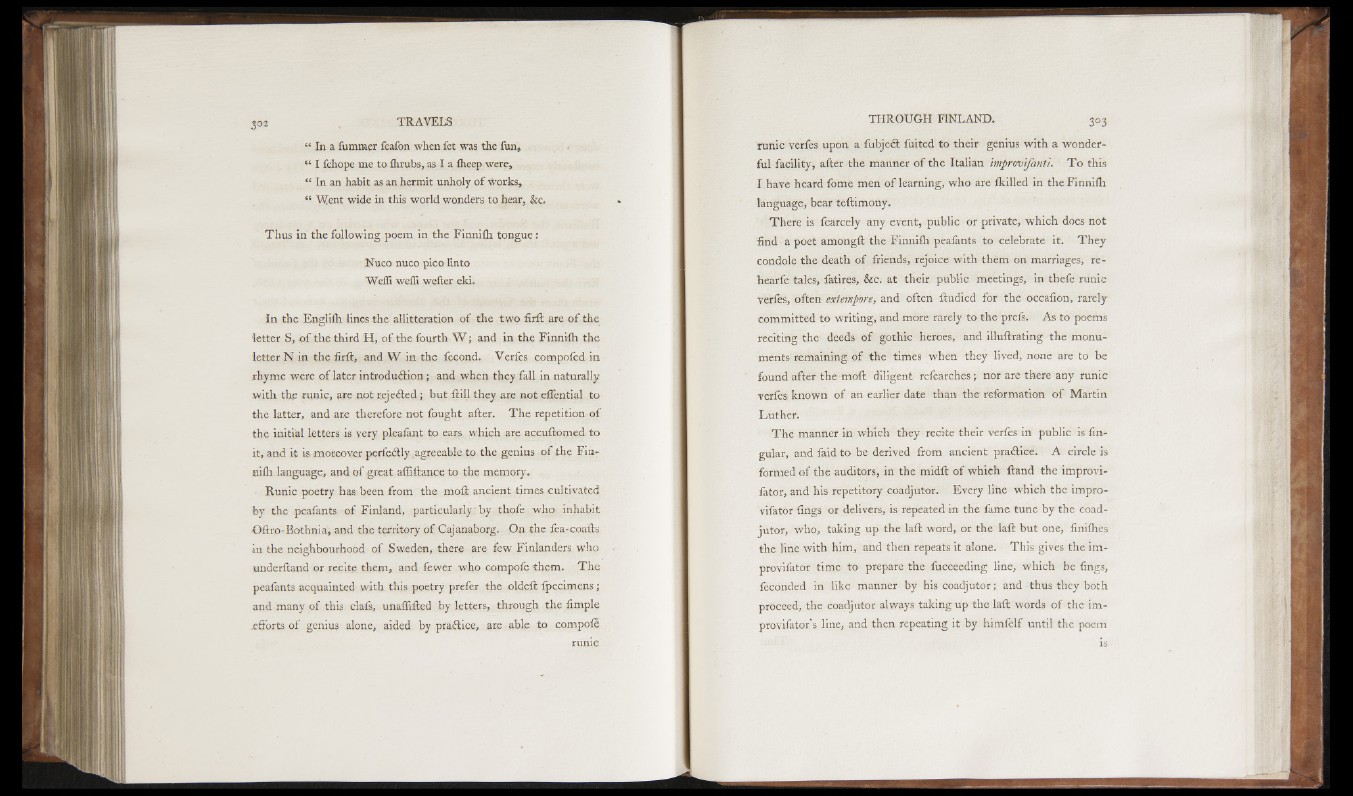
“ In a fummer feafon when fet was the fun,
« I fchope me to ihrubs, as I a fheep were,
“ In an habit as an hermit unholy o f works,
“ Went wide in this world wonders to hear, &c.
Thus in the following poem in the Finnifli tongue:
Nuco nuco pico linto
Wefii weffi wefter eki.
In the Engliih lines the allittaration o f the two firft are o f the
letter S, o f the third H, o f the fourth W ; and in the Finniih the
letter N in the firft, and W in the fecond. Verfes compofed in
rhyme were o f later introdu&ion; and when they fall in naturally
with the runic, are not rejected; but ftill they are not effential to
the latter, and are therefore not fought after. T he repetition o f
the initial letters is very pleafant to ears which are aceuftomed to
it, and it is moreover perfedUy .agreeable to the genius o f the Finniih
language, and o f great afliftance to the memory.
Runic poetry has been from the moft ancient times cultivated
by the peafants o f Finland, particularly’ by thofe who inhabit
Oftro-Bothnia, and the territory o f Cajanaborg. On the fea-coafts
in the neighbourhood o f Sweden, there are few Finlanders who
underftand or recite them, and fewer who compofe -them. T h e
peafants acquainted with this poetry prefer the oldeft fpecimens ;
and many o f this clafs, unaififted by letters, through the fimple
efforts o f genius alone, aided by practice, are able to compofe
runic
runic verfes upon a fubject fuited to their genius with a wonderful
facility, after the manner o f the Italian improvifanti. T o this
I have heard fome men o f learning, who are fkilled in the Finniih
language, bear teftimony.
There is fcarcely any event, public or private, which does not
find a poet amongft the Finniih peafants to celebrate it. T he y
condole the death o f friends, rejoice with them on marriages, re-
hearfe tales, fatires, &c. at their public meetings, in thefe runic
verfes, often extempore, and often ftudied for the occafion, rarely
committed to writing, and more rarely to the prefs. As to poems
reciting the deeds o f gothic heroes, and illuftrating the monuments
remaining o f the times when they lived, none are to be
found after the moft diligent refearches; nor are there any runic
verfes known o f an earlier date than the reformation o f Martin
Luther.
The manner in which they recite their verfes in public is fin-
guiar, and faid to be derived from ancient pradice. A circle is
formed o f the auditors, in the midft o f which ftand the improvi-
fator, and his repetitory coadjutor. Every line which the impro-
vifator fings. or delivers, is repeated in the fame tune by the coadjutor,
who, taking up the laft word, or the laft but one, finifhes
the line with him, and then repeats it alone. This gives the im-
provifator time to prepare the fucceeding line, which he fings,
feconded in like manner by his coadjutor; and thus they both
proceed, the coadjutor always taking up the laft words of the im-
provifator’s line, and then repeating it by himfelf until the poem
is